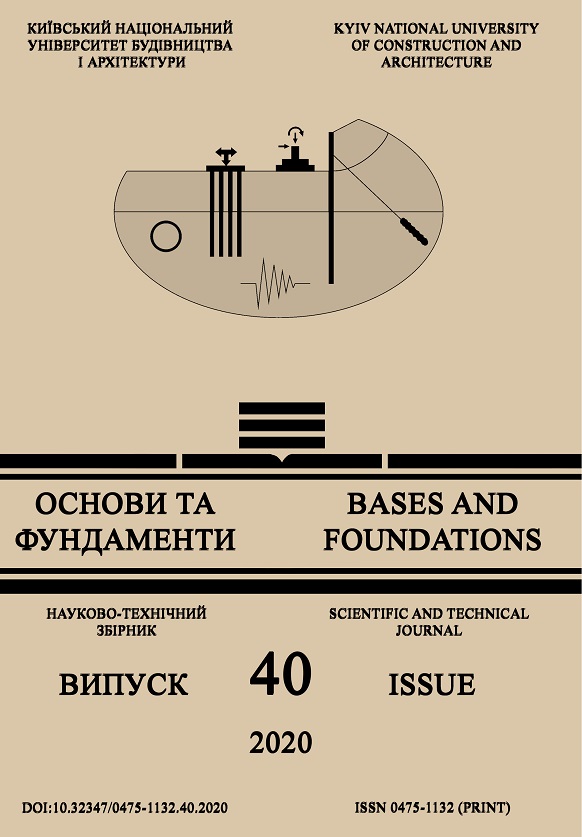Особливості влаштування лагун для сільськогосподарських цілей
Основний зміст сторінки статті
Анотація
На даний час у великих містах, містах-мільйонниках, спостерігається тенденція до будівництва великої кількості житлових багатоповерхових будівель та торговельно-розважальних комплексів на неосвоєних, вільних від забудови, ділянках міської території. Для забезпечення продовольчих потреб населення виникає необхідність у створенні великих скотарських комплексів. Україна, маючи значний природний ресурс, створила умови для приходу крупних міжнародних інвесторів. Тому протягом останніх років активно відбувається оновлення матеріально-технічної сільськогосподарської бази, що сприяє відродженню майже покинутої і занедбаної у 90-ті роки однієї із основних напрямків діяльності та спеціалізації нашої держави – сільського господарства. Розуміючи, потребу сучасного світу у вирощуванні органічних продуктів, освоєнні нових ринків збуту (у тому числі і за кордоном), відбувається модернізація, оновлення, переоснащення не лише застарілого, не ефективного обладнання, а й процесів виробництва, і як наслідок, будівель, споруд, комплексів. Це призводить до появи нових інженерних об’єктів, класифікацію, особливості будівництва, проектування та експлуатації яких необхідно досліджувати, висвітлювати в літературі, враховувати на різних етапах їх функціонування.Одним із таких об’єктів є «лагуни». В даній публікації приведено основне визначення спеціальної сільськогосподарської споруди –лагуни, представлено їх класифікацію за різними параметрами: місцезнаходженням, глибиною влаштування, формою та розмірами в плані, за умовами взаємодії з навколишнім середовищем, за матеріалом. Приведені основні технологічні процеси що впливають на проектування, будівництво і експлуатацію лагун. Відображено основні вимоги до матеріалів (геотекстиль, геомембрана), а також основні вимоги до їх зберігання, використання та влаштування при створенні водонепроникних екранів при будівництві лагун.
Показано практичне впровадження розглянутої сільськогосподарської конструкції та матеріалів для її будівництва.
Блок інформації про статтю

Ця робота ліцензується відповідно до Creative Commons Attribution 4.0 International License.
Автори, які публікуються у цьому журналі, погоджуються з наступними умовами: Автори залишають за собою право на авторство своєї роботи та передають журналу право першої публікації цієї роботи на умовах ліцензії Creative Commons Attribution License, котра дозволяє іншим особам вільно розповсюджувати опубліковану роботу з обов'язковим посиланням на авторів оригінальної роботи та першу публікацію роботи у цьому журналі. Автори мають право укладати самостійні додаткові угоди щодо неексклюзивного розповсюдження роботи у тому вигляді, в якому вона була опублікована цим журналом (наприклад, розміщувати роботу в електронному сховищі установи або публікувати у складі монографії), за умови збереження посилання на першу публікацію роботи у цьому журналі. Політика журналу дозволяє і заохочує розміщення авторами в мережі Інтернет (наприклад, у сховищах установ або на особистих веб-сайтах) рукопису роботи, як до подання цього рукопису до редакції, так і під час його редакційного опрацювання, оскільки це сприяє виникненню продуктивної наукової дискусії та позитивно позначається на оперативності та динаміці цитування опублікованої роботи (див. The Effect of Open Access).Посилання
Donald L., Charles D. (2000) Anaerobic Lagoons for Storage. Treatment of Livestock Manure.
Design of earthfill embankment dams. Available at: https://design-of-small-dams.appspot.com/structures.
Jones D. (2008) Manure Storage Systems. USA: Purdue University.
Navozokhranilishche i laguny dlya navoza i khraneniya prochikh tekhnicheskikh zhidkostey i vody. Available at: https://pvh-membrannaya-krovlya.ru/laguny-i-navozohranilishha (in Russian).
Navozokhranylyshche. Available at: https://www.agro-ferma.ru/dayatelnost/svinarnik/svinarnik-stati/navozokhranilishche (in Russian).
Metodicheskiye rekomendatsii po proyektiro-vaniyu sistem udaleniya i pererabotki navo-znykh stokov na svinokompleksakh promyshlennogo tipa / [uklad. : Vinogradov V.N., Sorokín N.T., Il'í̈n Í.V. ta ín.]. – Mos-kva, Ministerstvo sel'-skogo khozyaystva Rossiyskoy Federatsii, 2009 – 84с (in Russian).
Navozokhranylyshcha y rezervuary. Available at: https://agrotex.com.ua/ru/product-category/ navozoxranilishha-i-rezervuary (in Russian).
Systemy vydalennya, obrobky, pidhotovky ta vykorystannya hnoyu. VNTP-APK-09.06. – K.: Minahropolity-ky Ukrayiny, 2006 (in Ukrainian).
Lahuna Dlia Navoza. Available at: https://hydrozahist.com.ua/obyekt/laguna-dlya-navoza (in Russian).
Tekhnolohyia ukladky heotekstylia TyparSF V drenazhnykh konstruktsyiakh. Available at: https://geosvit.com.ua/am63-tehnologiya-ukladki-geotekstilya-typar-sf-v-landshaftnom-stroitelstve (in Russian).
Gidroizolyatsiya iskusstvennykh vodoyemov, ozer, poligony TBO. Available at: https://bk-giskon.com.ua/gidroizolyacziya-iskusstvennyh-vodoemov (in Russian).
Geomembrana: vse, chto nuzhno znat' o materi-ale dlya gidroizolyatsii. Available at: https://www.kp.ru/guide/geomembrana.html (in Russian).
Tekhnologiya svarki geomembrany, sposoby proverki soyedineniya. Available at: https://svarkoy.ru/teoriya/svarka-geomembrany.html (in Russian).
Instruktsiya po proyektirovaniyu i stroite-l'stvu protivofil'tratsionnykh ustroystv iz polietilenovoy plenki dlya iskustven-nykh vodoyemov. SN 551-82. – M.: Stroyizdat, 1983 (in Russian).
